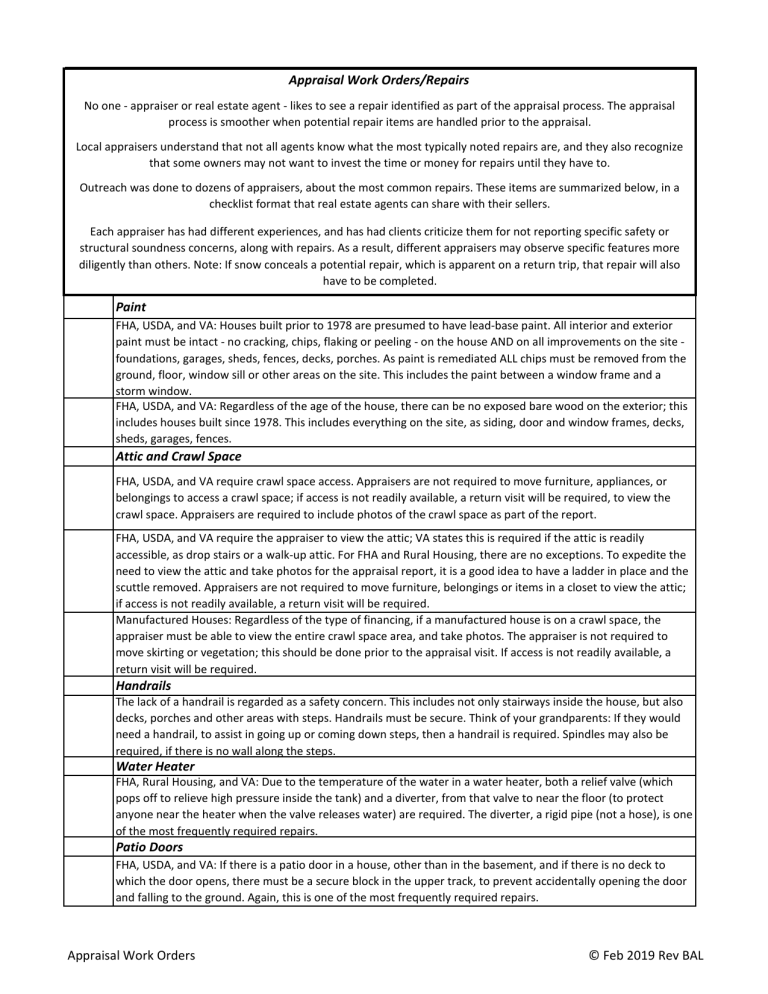
Appraisal Work Orders/Repairs No one - appraiser or real estate agent - likes to see a repair identified as part of the appraisal process. The appraisal process is smoother when potential repair items are handled prior to the appraisal. Local appraisers understand that not all agents know what the most typically noted repairs are, and they also recognize that some owners may not want to invest the time or money for repairs until they have to. Outreach was done to dozens of appraisers, about the most common repairs. These items are summarized below, in a checklist format that real estate agents can share with their sellers. Each appraiser has had different experiences, and has had clients criticize them for not reporting specific safety or structural soundness concerns, along with repairs. As a result, different appraisers may observe specific features more diligently than others. Note: If snow conceals a potential repair, which is apparent on a return trip, that repair will also have to be completed. Paint FHA, USDA, and VA: Houses built prior to 1978 are presumed to have lead-base paint. All interior and exterior paint must be intact - no cracking, chips, flaking or peeling - on the house AND on all improvements on the site foundations, garages, sheds, fences, decks, porches. As paint is remediated ALL chips must be removed from the ground, floor, window sill or other areas on the site. This includes the paint between a window frame and a storm window. FHA, USDA, and VA: Regardless of the age of the house, there can be no exposed bare wood on the exterior; this includes houses built since 1978. This includes everything on the site, as siding, door and window frames, decks, sheds, garages, fences. Attic and Crawl Space FHA, USDA, and VA require crawl space access. Appraisers are not required to move furniture, appliances, or belongings to access a crawl space; if access is not readily available, a return visit will be required, to view the crawl space. Appraisers are required to include photos of the crawl space as part of the report. FHA, USDA, and VA require the appraiser to view the attic; VA states this is required if the attic is readily accessible, as drop stairs or a walk-up attic. For FHA and Rural Housing, there are no exceptions. To expedite the need to view the attic and take photos for the appraisal report, it is a good idea to have a ladder in place and the scuttle removed. Appraisers are not required to move furniture, belongings or items in a closet to view the attic; if access is not readily available, a return visit will be required. Manufactured Houses: Regardless of the type of financing, if a manufactured house is on a crawl space, the appraiser must be able to view the entire crawl space area, and take photos. The appraiser is not required to move skirting or vegetation; this should be done prior to the appraisal visit. If access is not readily available, a return visit will be required. Handrails The lack of a handrail is regarded as a safety concern. This includes not only stairways inside the house, but also decks, porches and other areas with steps. Handrails must be secure. Think of your grandparents: If they would need a handrail, to assist in going up or coming down steps, then a handrail is required. Spindles may also be required, if there is no wall along the steps. Water Heater FHA, Rural Housing, and VA: Due to the temperature of the water in a water heater, both a relief valve (which pops off to relieve high pressure inside the tank) and a diverter, from that valve to near the floor (to protect anyone near the heater when the valve releases water) are required. The diverter, a rigid pipe (not a hose), is one of the most frequently required repairs. Patio Doors FHA, USDA, and VA: If there is a patio door in a house, other than in the basement, and if there is no deck to which the door opens, there must be a secure block in the upper track, to prevent accidentally opening the door and falling to the ground. Again, this is one of the most frequently required repairs. Appraisal Work Orders © Feb 2019 Rev BAL Access to Rooms and Outbuildings Appraisers are required to view ALL rooms in a house (some clients even require photos of all rooms) as well as the interiors of ALL buildings on the site (again, interior photos are typically required). If access is not provided, a return trip is required. Electric FHA, Rural Housing and VA: The appraiser is required to verify the operation of electrical switches and outlets in each room, in the garage, and on the outside of the house. Appraisers do not check every outlet, but a representative sampling Outlet covers are required - it is regarded as a safety hazard to have uncovered outlets; this includes for wall switches GFI: Many clients require ground fault indicator outlets near sources of water (kitchen, bathroom, laundry room). There should be an adequate number of outlets in each room. When an appraiser observes the use of extension cords (a tripping, as well as electric, hazard), it is likely an electrical inspection, with additional outlets installed, will be required. This is particularly true for the second floor of older houses. There should be no bare, exposed or uncapped wiring anywhere on the property, interior and exterior, including basements, attics, sheds and outbuildings. Water As a result of the Flint, MI water crisis, lenders are concerned about potable water, and may require appraisers to make additional comments or require repairs when there is a water filtration, reverse-osmosis, or water purification system. This applies to point-of-entry and point-of-use systems, and is in addition to tests on well water. Utilities FHA and USDA require ALL utilities to be on and operational at the time of the appraisal; this includes vacant houses. Appraisers are not required to turn on water at the meter; this should be done by the owner or agent. Heat should be operational during the winter and the air conditioning should be operational during summer weather. Photos are required of operational water, in vacant houses. Smoke Detectors and Carbon Monoxide Alarms While appraisers are not home inspectors, they are more frequently being asked by their clients to verify that appropriate detectors and alarms are installed; this includes photos and identification of their locations on the floor sketch. Deck Railings; Steps FHA, USDA, and VA (as well as some other clients): A lack of railings, with spindles, along decks and other areas elevated more than 30" from the ground poses a safety concern, so a railing will be required, at least 36" in height, with spindles spaced so that a 4" object cannot pass through. The maximum riser height is 7.75", with the maximum opening between risers of 4". The riser with the greatest height cannot exceed that of the smallest riser by more than .75" (tripping hazard) Drainage Negative drainage (toward the house) can result in moisture in the basement or crawl space. The ground around the foundation perimeter (and any sidewalks) should have a slope AWAY from the foundation. Garage Door Openers The self-reversing mechanism is required for safety, so it should be verified it is properly operational. Windows and Doors Exterior doors must be operational, for safety. Windows cannot be painted shut, for safety. Broken windows require repair, for safety. Appraisal Work Orders © Feb 2019 Rev BAL


